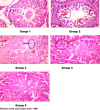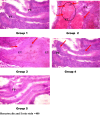Kaempferol mitigates reproductive dysfunctions induced by Naja nigricollis venom through antioxidant system and anti-inflammatory response in male rats
- PMID: 38365877
- PMCID: PMC10873395
- DOI: 10.1038/s41598-024-54523-w
Kaempferol mitigates reproductive dysfunctions induced by Naja nigricollis venom through antioxidant system and anti-inflammatory response in male rats
Abstract
Naja nigricollis Venom (NnV) contains complex toxins that affects various vital systems functions after envenoming. The venom toxins have been reported to induce male reproductive disorders in envenomed rats. This present study explored the ameliorative potential of kaempferol on NnV-induced male reproductive toxicity. Fifty male wistar rats were sorted randomly into five groups (n = 10) for this study. Group 1 were noted as the control, while rats in groups 2 to 5 were injected with LD50 of NnV (1.0 mg/kg bw; i.p.). Group 2 was left untreated post envenomation while group 3 was treated with 0.2 ml of polyvalent antivenom. Groups 4 and 5 were treated with 4 and 8 mg/kg of kaempferol, respectively. NnV caused substantial reduction in concentrations of follicle stimulating hormone, testosterone and luteinizing hormone, while sperm motility, volume and counts significantly (p < 0.05) decreased in envenomed untreated rats. The venom enhanced malondialdehyde levels and substantially decreased glutathione levels, superoxide dismutase and glutathione peroxidase activities in the testes and epididymis of envenomed untreated rats. Additionally, epididymal and testicular myeloperoxidase activity and nitric oxide levels were elevated which substantiated severe morphological defects noticed in the reproductive organs. However, treatment of envenomed rats with kaempferol normalized the reproductive hormones with significant improvement on sperm functional parameters. Elevated inflammatory and oxidative stress biomarkers in testis and epididymis were suppressed post kaempferol treatment. Severe histopathological lesions in the epididymal and testicular tissues were ameliorated in the envenomed treated groups. Results highlights the significance of kaempferol in mitigating reproductive toxicity induced after snakebite envenoming.
© 2024. The Author(s).
Conflict of interest statement
The authors declare no competing interest.
Figures





Similar articles
-
Echis ocellatus venom-induced sperm functional deficits, pro-apoptotic and inflammatory activities in male reproductive organs in rats: antagonistic role of kaempferol.BMC Pharmacol Toxicol. 2024 Aug 9;25(1):46. doi: 10.1186/s40360-024-00776-0. BMC Pharmacol Toxicol. 2024. PMID: 39123263 Free PMC article.
-
Naja nigricollis venom altered reproductive and neurological functions via modulation of pro-inflammatory cytokines and oxidative damage in male rats.Metabol Open. 2022 May 16;14:100188. doi: 10.1016/j.metop.2022.100188. eCollection 2022 Jun. Metabol Open. 2022. PMID: 35633732 Free PMC article.
-
Therapeutic potency of kaempferol against Naja haje venom induced neurotoxicity, inflammation, biological activities, and antioxidant system damage: a pre-clinical antivenom evaluation.Naunyn Schmiedebergs Arch Pharmacol. 2025 May;398(5):5939-5953. doi: 10.1007/s00210-024-03678-4. Epub 2024 Dec 2. Naunyn Schmiedebergs Arch Pharmacol. 2025. PMID: 39621086
-
Echis ocellatus Venom-Induced Reproductive Pathologies in Rat Model; Roles of Oxidative Stress and Pro-Inflammatory Cytokines.Toxins (Basel). 2022 May 29;14(6):378. doi: 10.3390/toxins14060378. Toxins (Basel). 2022. PMID: 35737039 Free PMC article.
-
4-Vinylcyclohexene diepoxide disrupts sperm characteristics, endocrine balance and redox status in testes and epididymis of rats.Redox Rep. 2017 Nov;22(6):388-398. doi: 10.1080/13510002.2016.1259718. Epub 2016 Nov 28. Redox Rep. 2017. PMID: 27892789 Free PMC article.
Cited by
-
Echis ocellatus venom-induced sperm functional deficits, pro-apoptotic and inflammatory activities in male reproductive organs in rats: antagonistic role of kaempferol.BMC Pharmacol Toxicol. 2024 Aug 9;25(1):46. doi: 10.1186/s40360-024-00776-0. BMC Pharmacol Toxicol. 2024. PMID: 39123263 Free PMC article.
-
Cryoprotective Potential of Theobromine in the Improvement of the Post-Thaw Quality of Bovine Spermatozoa.Cells. 2024 Oct 16;13(20):1710. doi: 10.3390/cells13201710. Cells. 2024. PMID: 39451229 Free PMC article.
-
Editorial: venom collection.Sci Rep. 2025 May 12;15(1):16411. doi: 10.1038/s41598-024-76017-5. Sci Rep. 2025. PMID: 40355561 Free PMC article.
-
Investigation of the molecular mechanism of Xiaoluo Wan in thyroid-associated ophthalmopathy: network analysis and in vivo study.Hereditas. 2025 Jul 22;162(1):137. doi: 10.1186/s41065-025-00499-0. Hereditas. 2025. PMID: 40696458 Free PMC article.
-
Effect and mechanism of modified Yougui power on Simmental bulls with oligoasthenozoospermia based on targeted amino acid metabolism.Front Vet Sci. 2025 Jun 18;12:1595145. doi: 10.3389/fvets.2025.1595145. eCollection 2025. Front Vet Sci. 2025. PMID: 40607342 Free PMC article.
References
-
- World Health Organization. Global snakebite burden: report by the Director General [WWW Document]. https://apps.who.int/iris/handle/10665/274115. Accessed 11.15.22 (2017)
-
- World Health Organization . Snakebite Envenoming: A Strategy for Prevention and Control. World Health Organization; 2019. p. 70.
-
- Gyawu, V. B. et al. Production and evaluation of monovalent anti-snake immunoglobulins from chicken egg yolk using Ghanaian puff adder (Bitis arietans) Venom: Isolation, purification, and neutralization efficacy. Toxicon231, 107180 (2023). - PubMed
MeSH terms
Substances
LinkOut - more resources
Full Text Sources
Medical
Research Materials

